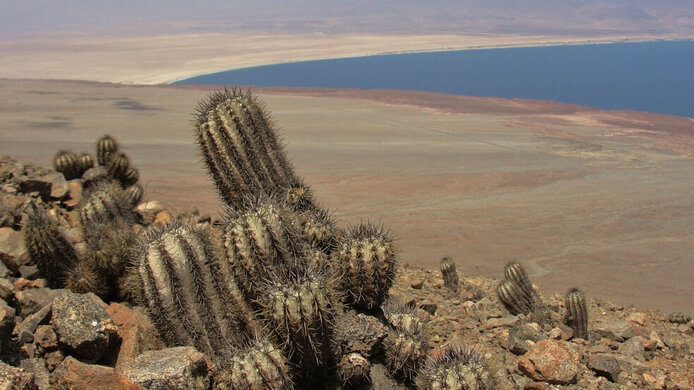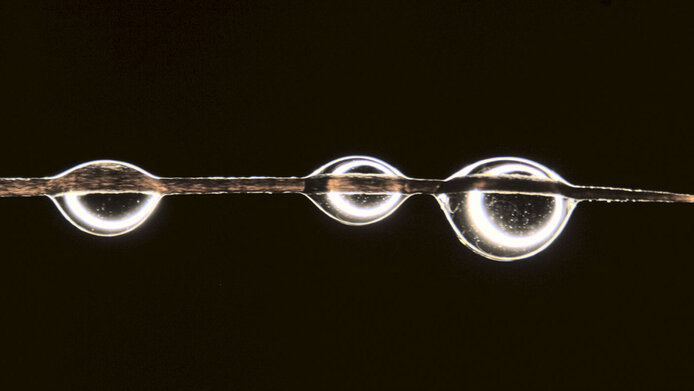Pointy water gatherers

While the Atacama Desert suffers from an absolute shortage of raindrops, the areas near the Pacific coast still boast thriving plants. These include cacti species of the Copiapoa genus, which harvest the fog that forms on the steep coast and is blown inland. The plants capture the tiny droplets from the air and store them in their body and roots.
Jessica Huss from the University of Natural Resources and Applied Life Sciences in Vienna is doing research on how the plants do this. “Cacti have a particular metabolism that is very advantageous in terms of energy use. That’s one of the reasons why they can manage water very efficiently,” Huss explains. As a materials scientist, she is interested in the multifunctional spines of these desert plants, which are useful for more than just fending off predators. “I want to learn how cactus spines have adapted to different environments over the course of evolution – and how they can collect fog or dew from the air,” says Huss. Her research project “Adaptations for fog and dew harvesting in cactus spines” is funded by the Austrian Science Fund FWF.
Cacti techniques
In addition to species of the Copiapoa genus, which grow in the Chilean Atacama Desert, plants Huss tested include the Turbinicarpus genus, which also harvest fog from the air in the mountainous regions of central Mexico. In addition, Huss is researching Echinocereus species from an area where there is hardly ever any fog: the Chihuahua Desert in the border region between the United States and Mexico. Huss keeps roughly 30 plants in a box in her office. In the laboratory she is investigating why some spines are better at repelling water and others are better at conducting it directly into the plant body or to the roots.
In what manner and how efficiently cacti collect and utilize moisture from the air also depends on the surface of the spines. Porous spines help to absorb droplets directly. On smooth spines water beads up, and the smooth surface helps direct water to the soil and thus to the roots. Some species of the Opuntia genus have refined this beading process with barbs and grooves on the spines that accelerate the dripping. “These and similar surface structures can help guide the droplets from the tip of the spine to the plant body or roots. Such features include parallel grooves or barbs located on the surface of the spine. Up to a certain degree, this droplet transport also works against gravity,” explains Huss.
3D images and time-lapse photography
Besides methods from her own field, Huss is also resorting to processes known from botany and plant physiology. Under the microscope or on macro camera images, she observes how the spines absorb droplets. If large droplets form on the surface of the spine, it has water repellent properties. There are also other imaging techniques that provide interesting insights. The researcher uses X-ray tomography, for instance, to create 3D images of the spines. Using a Raman microscope, on the other hand, provides information about the chemical composition and the distribution of different components in the tissue.
“In order to study water uptake, I also work with isotopes. I immerse the spines in heavy water and check whether it is later found in the main body of the cactus,” Huss explains. In order to do this, she analyzes the chemical composition of the water using mass spectrometry. By the end of the project in July 2025, she also wants to learn more about how cactus spines develop and about their chemical and general structure. A time-lapse camera helps Huss in this respect.
Huss keeps being intrigued by the results of her analyses. “It’s exciting to see how versatile and how different in appearance and behavior the spines are. One Turbinicarpus species can passively spread its flexible spines in the mist, literally straighten them up. I didn't expect the spines to move. That was fascinating,” she says.
What we can learn from cactus spines
What can humankind learn from natural functions and materials for its own inventions? This is one of the questions addressed by the research field of bionics, which is yielding many useful results. Suction cups modeled on the tentacles of octopuses are a case in point, or the walking pattern of crabs, which serves as inspiration for the locomotion of robots. Conducting grooves on cactus spines have also inspired an invention: a patch that collects sweat and without requiring any external energy input conducts it through channels to a sensor which analyzes the chemical components of the sweat. The patch can be used for health monitoring.
Jessica Huss's research illustrates that there is still a great deal that we can learn from plant spines. “If you could assemble a material’s structure in such a way that it could straighten up independently of energy sources – like the spines of the Turbinicarpus species – that would be exciting for technological applications,” she explains. Researchers in the field of robotics are investigating such autonomous materials, for example.
Incidentally, humans also collect fog from the air in the Atacama Desert. They do this using so-called fog catchers – nets that collect the drops which then run off into a gutter. As a consequence of the climate crisis, more and more areas are drying out. Accordingly, people in many more areas will have to resort to techniques to extract water from moisture in the air. “Insights into nature can help make fog-catching solutions more efficient,” Huss says. Such insights are facilitated by research, like the project that Huss is conducting on cactus spines.
Personal details
Jessica Huss is a postdoctoral researcher at the Institute of Biophysics at the University of Natural Resources and Life Sciences, Vienna. Since August 2022, she has been leading a research group there that focuses on elucidating the chemical, mechanical and structural properties of hard plant tissues with a focus on cactus spines. Huss received her doctorate in materials science from the Technical University of Berlin and the Max Planck Institute of Colloids and Interfaces. She contributed results of her research to the exhibition “Bioinspiration. Innovation inspired by nature.” which can be seen at the Technical Museum in Vienna until September 3, 2023. The project “Adaptations for fog and dew harvesting in cactus spines” has been awarded EUR 297,100 in funding from the Austrian Science Fund FWF.






